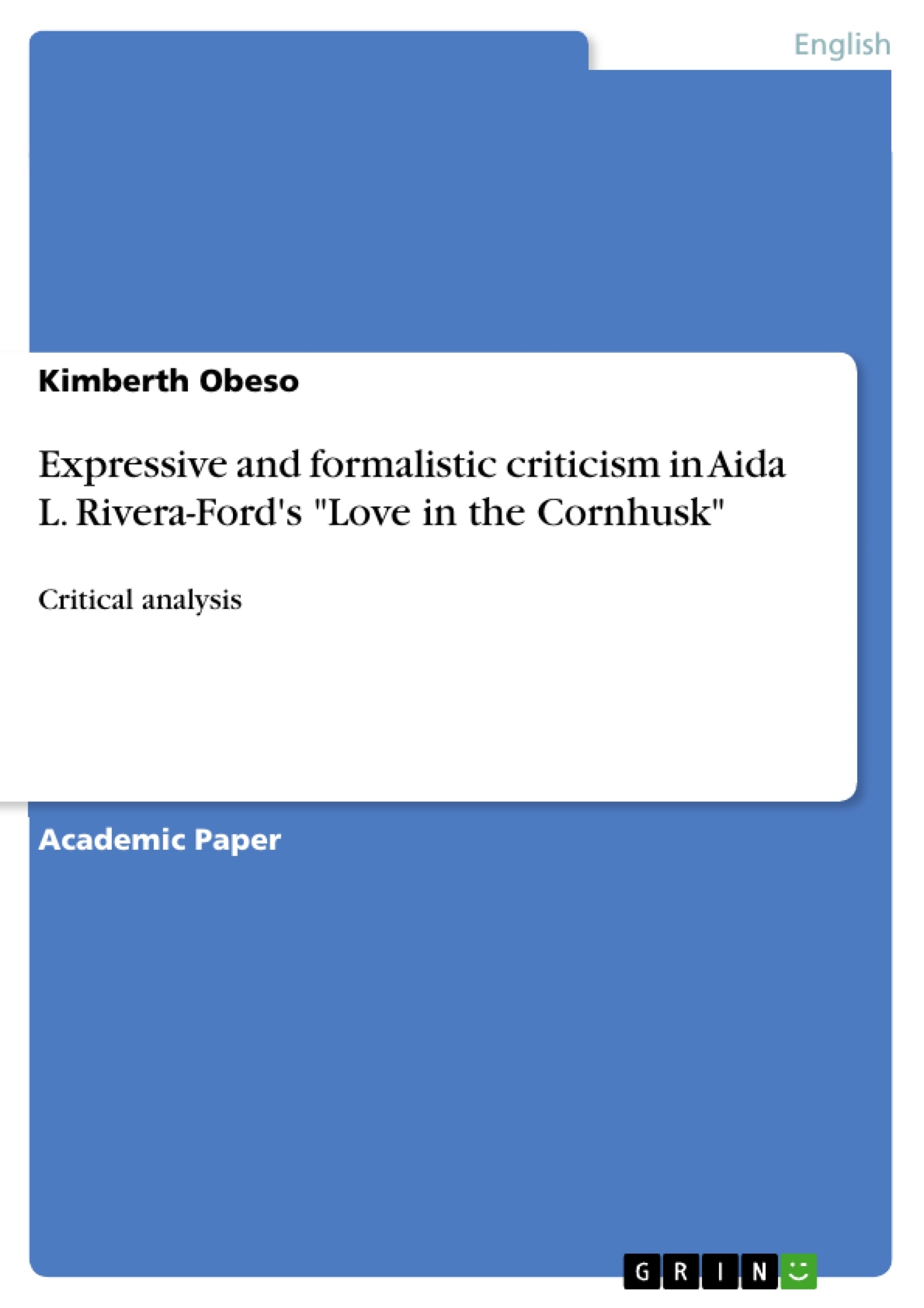“Love in Cornhusk” is a short story written by Aida L. Rivera-ford. She is a Filipina writer whose masterpiece delineates local colors and old identities. Short story as one of the genres in literature refers to a short work of fiction (Klarer 12).
Aida’s work recounted the story of Tinang who came to visit Señora. She, on the other hand, was troubled by his past romantic attachments with Amado. Senora told her about the letter in the post office. Along with her child, they left thereafter. While reading the letter and situating herself on a cornhusk, a serpent came in unexpectedly. The story concluded after she dropped the letter unconsciously as she maneuvered to secure her child (Rivera-ford 58-64). Throughout the narrative, she found herself congested with her past amorous relationship. However, she came to realize that her spiteful memory must be buried in the past. This story adhered in the illusion of the character’s intimate feelings. Grow asserts that parting and abandonment depict the thematic development in the story (42-45).
Table of Contents
- Introduction
- Discussion
- Author's Presence in the Text
- Structural Identities
- Conclusion
Objectives and Key Themes
The objective of this critical analysis is to examine Aida L. Rivera-Ford's "Love in the Cornhusk" through expressive and objective critical lenses. It seeks to reveal the author's presence within the text and analyze the story's structural identities, using relevant biographical information and literary devices.
- The author's biographical influences on the narrative.
- The exploration of themes of love, loss, and moving on.
- Analysis of literary devices and their contribution to the story's meaning.
- Examination of the story's structure and its impact on the narrative.
- The use of setting and symbolism to convey deeper meaning.
Chapter Summaries
Introduction: This chapter introduces Aida L. Rivera-Ford's "Love in the Cornhusk," briefly summarizing the plot and highlighting the author's background as a Filipina writer known for depicting local color and old identities. It establishes the methodology of the critical analysis, which will employ both expressive and objective critical theories to examine the author's presence in the text and the story's structural elements. The chapter clearly states the intention to use biographical information and literary analysis to interpret the story.
Discussion: This chapter presents a detailed analysis of "Love in the Cornhusk," divided into two main sections. The first section explores the author's presence within the narrative by comparing events in the story to biographical details from Rivera-Ford's life. It draws parallels between the protagonist's experiences and the author's own life, including her relationships, travels, and upbringing. The analysis reveals how the author's personal experiences influence the story's themes and characters. The second section focuses on the story's structural elements, analyzing literary devices such as setting, characterization, conflict, point of view, and symbolism. It meticulously examines how these elements contribute to the story's overall meaning and impact. The chapter effectively synthesizes the findings from both the biographical and structural analyses, offering a multifaceted understanding of the story's complexities.
Keywords
Aida L. Rivera-Ford, Love in the Cornhusk, Expressive Criticism, Formalistic Criticism, Philippine Literature, Biographical Criticism, Literary Devices, Setting, Characterization, Symbolism, Theme, Love, Loss, Abandonment.
Frequently Asked Questions: Aida L. Rivera-Ford's "Love in the Cornhusk" Critical Analysis
What is this document?
This document is a comprehensive language preview of a critical analysis of Aida L. Rivera-Ford's short story, "Love in the Cornhusk." It provides an overview including the table of contents, objectives, key themes, chapter summaries, and keywords.
What are the main objectives of the critical analysis?
The analysis aims to examine "Love in the Cornhusk" through expressive and objective critical lenses. It focuses on revealing the author's presence in the text and analyzing the story's structural identities, using biographical information and literary devices. Specific objectives include exploring the author's biographical influences, analyzing themes of love, loss, and moving on, examining literary devices, and analyzing the story's structure and use of setting and symbolism.
What are the key themes explored in the analysis?
The key themes explored include the author's biographical influences on the narrative, love, loss, moving on, and the impact of literary devices, setting, and symbolism on the story's meaning.
What is covered in the Introduction chapter?
The introduction introduces "Love in the Cornhusk," summarizing the plot and highlighting Rivera-Ford's background as a Filipina writer. It establishes the methodology of the analysis, which uses expressive and objective critical theories to examine the author's presence and the story's structural elements. It clearly states the intention to use biographical information and literary analysis.
What is covered in the Discussion chapter?
The discussion chapter provides a detailed analysis of "Love in the Cornhusk" in two sections. The first explores the author's presence by comparing events in the story to biographical details from Rivera-Ford's life. The second section focuses on the story's structural elements (setting, characterization, conflict, point of view, and symbolism), examining how they contribute to the story's meaning. The chapter synthesizes findings from both biographical and structural analyses.
What are the keywords associated with this analysis?
Keywords include: Aida L. Rivera-Ford, Love in the Cornhusk, Expressive Criticism, Formalistic Criticism, Philippine Literature, Biographical Criticism, Literary Devices, Setting, Characterization, Symbolism, Theme, Love, Loss, Abandonment.
What kind of critical approaches are used in this analysis?
The analysis employs both expressive and objective critical theories. This likely includes biographical criticism (examining the author's life and how it informs the work) and formalistic criticism (focusing on the text's structure and literary devices).
What is the overall purpose of this document?
The purpose is to provide a structured and professional overview of a critical analysis of "Love in the Cornhusk," allowing for a quick understanding of the analysis's scope, methodology, and findings. It is intended for academic use, facilitating the analysis of themes in a structured manner.
- Quote paper
- B.A English-Literature Kimberth Obeso (Author), 2020, Expressive and formalistic criticism in Aida L. Rivera-Ford's "Love in the Cornhusk", Munich, GRIN Verlag, https://www.grin.com/document/539780




